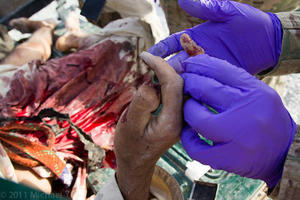Battlefield forensicsAdvanced forensic tool for the battlefield
A forensic tool could soon make the analysis of evidence faster and more accurate, giving military investigators an advantage in the wars against drugs and terror

The objective is to accelerate forensic analysis at the battlefield // Source: lineofdeparture.com
A forensic tool being developed by University of North Texas professor Dr. Guido Verbeck could soon make the analysis of evidence faster and more accurate, giving military investigators an advantage in the wars against drugs and terror.
Using a grant from the Department of Defense Battlefield Forensic Program, Verbeck, an assistant professor of chemistry at the University of North Texas (UNT), is developing a small-scale forensic workstation for use in military field labs. A University of North Texas release reports that the station combines the ability to manipulate samples on the nano-scale with mass spectrometry to allow scientists to collect and analyze chemical samples from within the ridges of a fingerprint using a single device.
Verbeck says that integrating these abilities into one, portable tool will save military investigators both time and money, and also contribute to more accurate findings.
Currently, most samples need to be sent to a more established lab for sophisticated analysis. The ability to collect samples from scraps of debris, drugs or other illicit materials and analyze them in the field will decrease the amount of time required to determine the origin, composition and history of the substance. By increasing the efficiency of the process, investigators will have better odds of locating and detaining suspects before they leave the area or commit more crimes.
“Each substance and individual produces unique chemical signatures, and by analyzing samples investigators may be able to tell who’s touched an explosive device or a drug stockpile because the chemistry is connected. This ability will help draw connections between suspects and cases that might not otherwise be identified,” says Verbeck.
The release notes that Verbeck invented a larger version of this device in 2006, based on a manipulation system for nanoprobing in scanning electron microscopes developed by Zyvex Instruments in Richardson, Texas. Verbeck refers to his device as the “nanomanipulator.” He has been using the device for a variety of forensic and biological applications, including sampling drug and biological samples from individual fibers, electrostatic lifts and direct biological samples.
The workstation in development will be less than a quarter of the size of the current device. The probe used for collecting samples can be attached to any microscope, and the electronic components of the device will be contained in a box not much larger than a DVD player.
The Department of Defense provided Verbeck and his team with more than $186,000 to develop the device, which could be rolled out to field labs around the world as early as next year.
